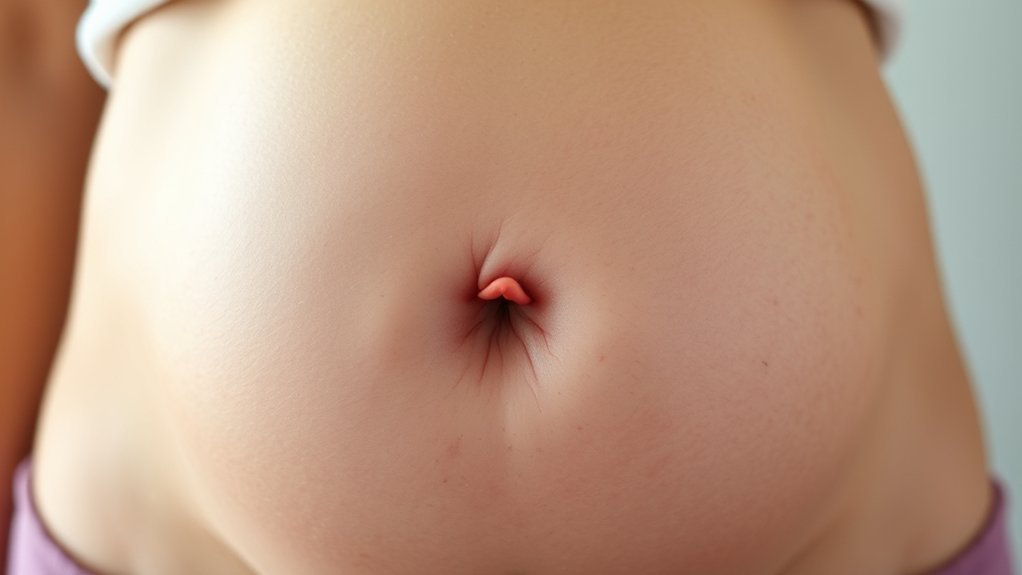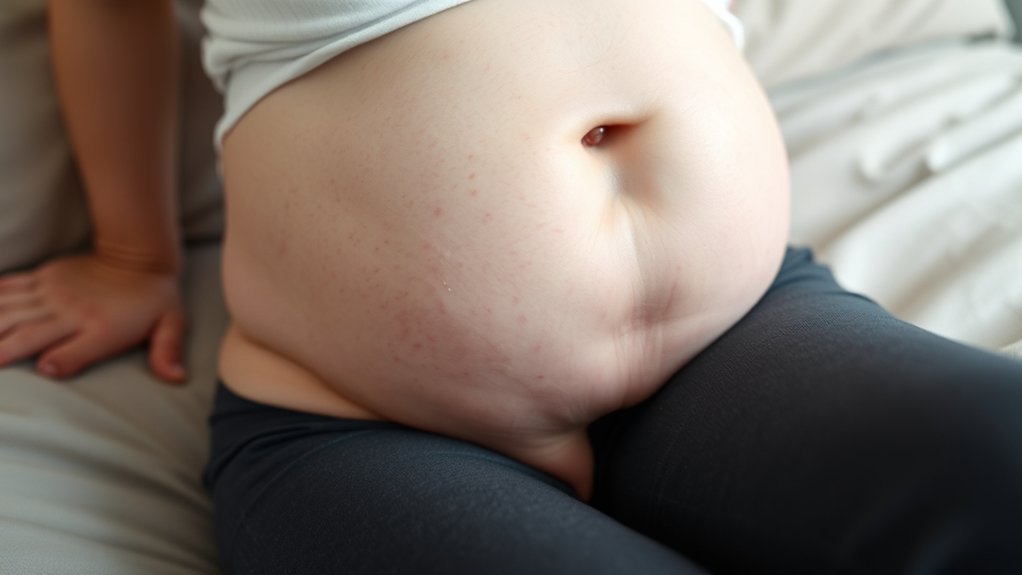Imagine feeling a sharp, uncomfortable pressure in your lower abdomen, a reminder of the recent changes your body has undergone. If you’ve recently given birth, you might find yourself grappling with postpartum hemorrhoids, which can bring about distressing symptoms like pain, itching, and even bleeding. Understanding these signs is essential for your comfort and recovery, and knowing how to identify and manage them can make a significant difference in your healing journey.
What Are Postpartum Hemorrhoids?

Postpartum hemorrhoids are a common yet uncomfortable condition many women face after childbirth. They consist of swollen veins in the rectum and anal passage, often affecting 25 to 35 percent of women, particularly after vaginal delivery.
These hemorrhoids develop due to increased pressure in the pelvic area during pregnancy and delivery, combined with hormonal changes that weaken vein walls. Symptoms can include pain, itching, and discomfort, especially during bowel movements.
Constipation, a frequent issue postpartum, can exacerbate these symptoms as straining may occur. Fortunately, most cases resolve within days to weeks with appropriate home treatments.
These may include dietary changes, increased hydration, and soothing methods like sitz baths to alleviate discomfort and promote healing.
Symptoms of Postpartum Hemorrhoids
After giving birth, you might notice various uncomfortable symptoms that can signal the presence of hemorrhoids.
Pain and discomfort in the anal area, especially during bowel movements, is a common complaint. You may also experience itchiness and burning sensations due to irritation from swollen hemorrhoidal veins.
Pain and discomfort in the anal area during bowel movements can be a common postpartum issue, often accompanied by itchiness and burning sensations.
Bright red bleeding, often visible on toilet paper or in your stool, is another significant indicator of postpartum hemorrhoids. You might feel sensitive lumps or swelling around the anal opening, which can be classified as either internal or external hemorrhoids.
It’s important to know that approximately 43% of women face this issue during the postpartum period, so you’re not alone in dealing with these distressing symptoms.
Causes of Postpartum Hemorrhoids
Experiencing symptoms of hemorrhoids can be distressing, but understanding the underlying causes can help you manage them more effectively.
Postpartum hemorrhoids often arise from several factors:
- Increased pressure on the veins due to the weight of your growing baby
- Swelling and discomfort caused by hormonal changes that slow digestion
- Straining during labor, especially during vaginal delivery, which enlarges rectal veins
- Constipation, frequently worsened by dietary changes during pregnancy
- Weakened valves in rectal veins from weight gain and altered blood flow
These factors create a conducive environment for hemorrhoids to form.
Prioritizing postpartum care, like adopting a high-fiber diet, can help alleviate some of these issues and promote healing.
How to Identify Postpartum Hemorrhoids

How can you tell if you’re dealing with postpartum hemorrhoids? It’s important to recognize the symptoms that often affect women after childbirth. You may experience discomfort in the anal area, itchiness, or visible lumps around the anus. Bleeding during bowel movements—often appearing as bright red blood on toilet paper—is also a common sign. Hemorrhoids can be internal, occurring inside the rectum, or external, located around the anal opening.
| Symptoms | Description |
|---|---|
| Discomfort | Pain or sensitivity in the anal area |
| Visible lumps | Swelling around the anal opening |
| Bleeding during bowel movements | Bright red blood on toilet paper |
Awareness of these symptoms can help you seek necessary medical advice if they persist.
Treatment Options for Postpartum Hemorrhoids
When managing postpartum hemorrhoids, a variety of effective treatment options are available to help alleviate your discomfort. You can start with these simple strategies:
- Over-the-counter creams or ointments to soothe pain and itching.
- Sitz baths for 15 minutes several times a day to reduce swelling.
- Ice packs or cold compresses on the anal area for 20 to 30 minutes to ease inflammation.
- Increase dietary fiber through fruits, vegetables, and whole grains to prevent constipation.
- Consult your care provider if symptoms persist for more than seven days or you experience significant rectal bleeding.
These home treatment options can provide relief, but don’t hesitate to seek professional help if your condition worsens.
Home Remedies for Postpartum Hemorrhoids
Although postpartum hemorrhoids can be uncomfortable, several effective home remedies can help you find relief.
First, incorporate a high-fiber diet rich in fruits, vegetables, and whole grains to soften stools and ease constipation. Staying hydrated is essential; aim for at least eight cups of water daily, especially if you’re breastfeeding.
Consider taking sitz baths for about 15 minutes several times a day to provide soothing relief and shrink hemorrhoids. Applying ice packs wrapped in cloth for 20 to 30 minutes can greatly reduce swelling and alleviate pain.
Finally, use witch hazel on cotton balls or pads directly on the affected area to help reduce swelling and discomfort from postpartum hemorrhoids. Additionally, it’s important to consult with your healthcare provider about prenatal care and check-ups to ensure your recovery is on track.
Dietary Changes to Alleviate Symptoms

To alleviate postpartum hemorrhoid symptoms, making dietary changes is essential.
You should focus on incorporating high-fiber foods, staying well-hydrated, and avoiding constipation triggers like caffeine and sugary drinks.
These adjustments can greatly improve your comfort during recovery.
High-Fiber Food Choices
Incorporating high-fiber foods into your diet can markedly alleviate postpartum hemorrhoid symptoms. A high-fiber diet softens stools, helps prevent constipation, and supports healthy bowel movements.
Aim for at least 25 grams of fiber daily to promote regularity. Here are some fiber-rich food choices to contemplate:
- Berries (like raspberries and blackberries)
- Apples (with the skin on)
- Broccoli (steamed or raw)
- Lentils (great in soups or salads)
- Oats (perfect for breakfast)
Hydration Importance
Staying properly hydrated is crucial for your postpartum recovery, as it plays a key role in preventing constipation and alleviating hemorrhoid symptoms.
Aim for at least eight cups of water daily, increasing to 12-14 cups if you’re breastfeeding. This level of hydration supports milk production and helps maintain healthy digestion.
When you combine adequate water intake with a high-fiber diet, you’ll soften your stools, making bowel movements easier and reducing strain on hemorrhoids.
It’s also important to steer clear of beverages like coffee, tea, and soda, which can worsen constipation.
Avoid Constipation Triggers
Maintaining hydration is just the first step in managing postpartum hemorrhoids; dietary changes also play a significant role in preventing constipation. A high-fiber diet and mindful habits can help you achieve regular bowel movements, reducing the risk of discomfort.
Here are some tips to avoid constipation triggers:
- Eat plenty of fruits, vegetables, legumes, and whole grains.
- Drink at least eight cups of water daily, especially if you’re breastfeeding.
- Limit beverages like coffee, tea, and soda that can worsen constipation.
- Engage in light exercise, such as walking, to stimulate bowel function.
- Respond promptly to bathroom urges to prevent drier, harder stools.
Implementing these changes can lead to pain relief and a more comfortable postpartum recovery.
When to Seek Medical Attention
If you notice that your hemorrhoids persist after a week of at-home treatment, it’s essential to seek medical attention, as this could signal the need for more aggressive interventions.
Be vigilant for significant rectal bleeding that exceeds a small amount, as this may indicate a more serious condition requiring prompt evaluation.
If your hemorrhoids become thrombosed or protrude without retracting, a healthcare provider should assess your situation for potential treatment options.
Additionally, watch for symptoms like fever, chills, or severe abdominal pain, which could suggest an infection or other complications.
Regular postpartum checkups are vital for monitoring your recovery and addressing any ongoing issues related to hemorrhoids or other health concerns you may face.
Frequently Asked Questions
How Do I Know if I Have Hemorrhoids After Birth?
You might have hemorrhoids if you notice pain, discomfort, or itchiness around your anal area, especially during bowel movements. Observing any bright red bleeding or sensitive lumps also indicates you should seek medical advice promptly.
How Long Do Postpartum Hemorrhoids Last?
Postpartum hemorrhoids typically last a few days to six weeks. You’ll likely see improvement with at-home treatments. If symptoms persist beyond a week, it’s best to consult your healthcare provider for further evaluation.
Can Hemorrhoids Cause Diarrhea?
Hemorrhoids don’t directly cause diarrhea, but they can create a painful cycle affecting bowel habits. If you’re experiencing diarrhea alongside hemorrhoids, seeking medical advice can help address both issues and alleviate discomfort effectively.
How to Get Rid of Postpartum Haemorrhoids?
To get rid of postpartum hemorrhoids, increase your fiber intake, stay hydrated, engage in light exercise, and use warm sitz baths. If symptoms persist after a week, consult your healthcare provider for further options.
Conclusion
Steering through postpartum hemorrhoids can feel like a stormy sea, with discomfort and pain often overwhelming your journey into motherhood. However, understanding your symptoms and seeking appropriate treatment can help you weather the turbulence. Just as the sun breaks through after a storm, relief and healing are within reach. Remember, you’re not alone in this experience—reach out for support and explore both medical and home remedies to reclaim your comfort and well-being during this precious time.
